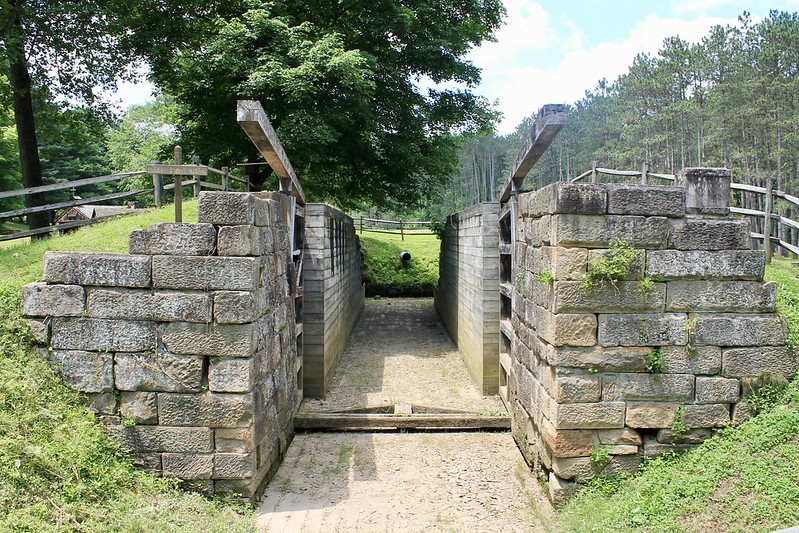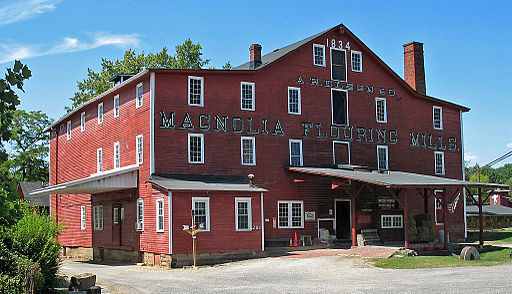The early success of the Ohio & Erie Canal inspired the creation of other canals, which grew their own communities, including the Sandy & Beaver Canal and the village of Magnolia.
Many canal villages sprung up along the Ohio & Erie Canal as it was built and became a commercial highway. But the success of the Ohio & Erie Canal inspired the creation of other canals as well, which grew their own communities, including the Sandy & Beaver Canal and the village of Magnolia.
Magnolia took shape in 1834 as a direct result of the construction of the Sandy & Beaver Canal, which linked Glasgow, Pennsylvania to the Ohio & Erie Canal in Bolivar, Ohio. Magnolia merged with Downingville in 1846 due to its promising future as a canal village and became a city spanning the borders of two counties, Carroll and Stark County.
While the canal village still stands today, the Sandy & Beaver Canal had a complicated start and its commercial usage was short-lived.
In 1828, the Ohio legislature published a charter for the Sandy & Beaver Canal, but construction and commercial usage of the Sandy & Beaver Canal did not go as planned, with construction taking nearly 20 years to complete.
In 1834, canal construction began, with the plan to include seven aqueducts and 100 locks spanning 90 miles of canal. However, the financial panic of 1837 led to a delay in construction and 90 percent of canal workers were laid off. The project began with about 2,000 workers. After the Panic of 1837, the workforce shrank to about 200 workers.

The Sandy & Beaver Canal had 90 locks just like Lock 36. Photographer: Jon Dawson, Flicker, Sandy & Beaver Canal Lock 36, June 17, 2018. Attribution-NoDerivs 2.0 Generic (CC BY-ND) License 2.0 https://creativecommons.org/licenses/by-nd/2.0/
Despite the shrunken workforce, two tunnels needed to be dug for the canal. The Little Tunnel was completed in 1846 and the Big Tunnel was completed in 1848. It took two more years for the canal to carry regular commercial traffic due to the water level in the tunnels being lower than what was needed for commercial freights. Even after the Sandy & Beaver Canal opened, local industry and agriculture sparingly utilized the western and eastern portions of the canal. because travel along the entirety was simply not possible because the middle portion of the canal was inaccessible due to the water level. Therefore, the Sandy & Beaver Canal’s two main purposes, connect the Ohio River with the Ohio & Erie Canal, and increase commercial traffic between Glasgow, Pennsylvania and Bolivar, Ohio, were never fully realized.
By 1852, canal operations were discontinued altogether when the Cold Run Reservoir Dam in Lisbon, Ohio, broke, damaging an extensive portion of the canal and flooding numerous homes and businesses. It was determined that the Sandy & Beaver Company was not able to pay off the existing construction costs or the repair costs for the damaged portions of the canal. Although the Sandy & Beaver Canal encompassed about 73 miles with 90 canal locks, the canal was only operational for four years and the Sandy & Beaver Company went under with the Sandy & Beaver Canal.
Today, you can schedule a tour of the historic Magnolia Flouring Mills, which was erected along the Sandy & Beaver Canal in 1834 by the founder of Magnolia, Richard Elson. Behind this historic mill, a small portion of the Sandy & Beaver Canal is still visible. The mill was passed down within the Elson family for 171 years until 2005 when the Stark County Park District acquired the property.

The Elson Family ran the Magnolia Flouring Mills for over 170 years and today visitors can request to tour this historic mill. Elson Family’s Magnolia Flouring Mills, Wikimedia Commons, Contributor: Sanfranman59, August 25, 2008. This file is licensed under the Creative Commons Attribution-Share Alike 3.0 Unported, 2.5 Generic, 2.0 Generic and 1.0 Generic license.
The mill stands as a reminder of Magnolia’s heritage as a small agricultural community along the Sandy & Beaver Canal, earning the mill a spot on the National Register of Historic Places in 2005. The mill is undergoing repairs so that it can educate the public on how grist mills operated. Magnolia Flouring Mills will be the site of the future trailhead for Pleasant Valley Trail and Sandy & Beaver Canal Trail.
To learn more about Magnolia Flouring Mills and how to schedule a tour visit: http://starkparks.com/parks/magnolia-flouring-mills/
Downing, Bob. “Historic Mill to Take a New Turn.” Akron Beacon Journal. April 30, 2007.
“History.” Village of Magnolia: Historic Village in Eastern Ohio, November 4, 2017. https://villageofmagnolia.com/home/.
“Magnolia Flouring Mills.” Stark Parks, 2021. https://starkparks.com/parks/magnolia-flouring-mills/.
Musarra, Russ. “Magnolia and the Sandy & Beaver Canal.” Essay. In Canal Fever: The Ohio & Erie Canal from Waterway to Canalway, edited by Lynn Metzger and Peg Bobel, 268–70. Kent, OH: Kent State University Press, 2009.
“Sandy & Beaver Canal-Canal Sites.” Canal Society of Ohio. Accessed October 25, 2022. http://www.canalsocietyohio.org/sandy---beaver-canal.html.
“Sandy and Beaver Canal.” Ohio History Central. Accessed October 22, 2022. https://ohiohistorycentral.org/w/Sandy_and_Beaver_Canal?rec=797.
Tamburro, Sam. “The History of the Ohio & Erie Canal.” Essay. In Canal Fever: The Ohio & Erie Canal from Waterway to Canalway, edited by Lynn Metzger and Peg Bobel, 3–18. Kent, OH: Kent State University Press, 2009.